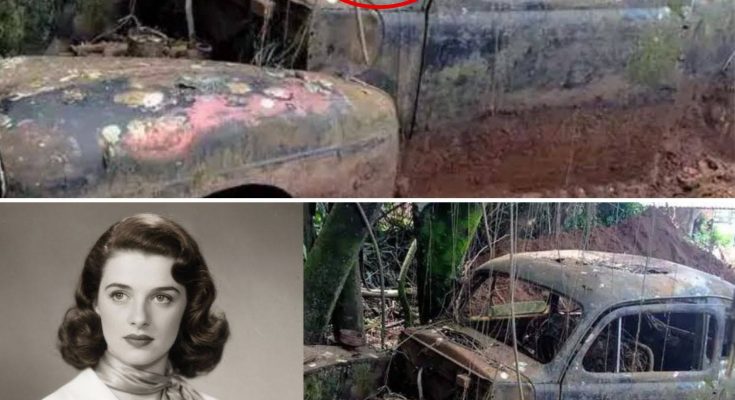The fertile soil of Jalisco, Mexico—known for nurturing the blue agave that gives life to tequila—has always held more than roots. It holds stories. And few stories are as mysterious, tragic, and hauntingly beautiful as that of Daniela Augusto Ferreira, the young heiress whose disappearance in 1951 became one of the region’s most whispered legends.

Her family’s name carried weight across Guadalajara. The Ferreiras were not just wealthy—they were woven into the fabric of the state’s identity. Landowners, philanthropists, and patrons of the arts, they embodied the golden age of Jalisco’s aristocracy. Daniela, their only daughter, was the jewel of the dynasty: educated in Europe, elegant yet rebellious, known for her raven hair, sapphire eyes, and the black Ford Coupé she loved to drive through the countryside.
On a warm April evening, both she and that car vanished.
A Vanishing in the Night
The last time anyone saw Daniela was on the evening of April 14, 1951. She had left the family hacienda, San Miguel de las Flores, after an argument with her father, Don Arturo Ferreira, one of the region’s most powerful landowners.
Witnesses said she drove away in her sleek Ford Coupé, the engine roaring down the dusty road that led toward Lake Chapala. She was alone. The next morning, her car was gone, her room untouched, and her father’s servants began whispering that something terrible had happened.
By noon, Guadalajara’s newspapers carried the headline:
“Prominent Heiress Missing — Search Underway Across Jalisco.”
For weeks, hundreds of locals joined the search. Planes circled the lakeside. Police scoured ravines and riverbeds. But no trace of Daniela—or her car—was ever found.

Theories, Rumors, and the Weight of a Family Name
In the conservative, image-obsessed society of 1950s Guadalajara, scandal was as feared as death. The Ferreiras insisted that Daniela had “gone to visit relatives abroad.” But behind closed doors, whispers began to spread.
Some said she had eloped with a ranch hand, a man her father forbade her to see. Others believed she had been kidnapped for ransom, though no demand was ever made. There were darker theories too—that Daniela had been the victim of her own family’s pride, silenced after bringing shame to their name.
One of the servants, interviewed decades later, recalled hearing muffled shouting from the stables that night:
“The Don’s voice was furious. Then there was a woman crying. After that… nothing.”
The following morning, workers noticed that a patch of the orchard near the western wall had been freshly tilled.
No one dared to ask why.
The Decades of Silence
For nearly half a century, the disappearance of Daniela Ferreira faded into legend. The Ferreiras themselves slowly withdrew from public life. Don Arturo died in 1964, never speaking her name again. Her mother, Doña Estela, became a recluse until her death in 1972.
The estate, once a symbol of power, fell into disrepair. Weeds swallowed the driveway where Daniela’s Ford had once gleamed. The gates rusted. Locals said the hacienda was cursed—that at night, lights flickered in the empty windows, and a woman’s laughter could be heard near the orchard.
Every few years, journalists or students would revisit the case, but it always ended the same way: no clues, no answers, just silence buried beneath generations of dust.
The Discovery
That silence finally broke in 1999.
A construction company had purchased part of the old Ferreira property to build a modern housing complex. On August 2, as workers dug the foundation for a new street, a backhoe struck metal about six feet below the surface. The operator, thinking it was debris from an old irrigation system, kept digging—until the curved frame of a car roof emerged.
The local police were called immediately. By the next morning, archaeologists, journalists, and curious onlookers surrounded the site. What they uncovered left the entire state in shock.
Beneath layers of soil and clay rested a black 1949 Ford Coupé, remarkably intact. The doors were sealed shut, the windows coated with mud. When investigators pried them open, the stale air that escaped carried a metallic, haunting scent.
Inside the driver’s seat was the skeleton of a young woman.
Forensic Revelation
Forensic teams from Mexico City quickly took over the investigation. Based on the condition of the remains, the woman had likely died in the early 1950s. Her teeth and skull structure matched dental records from the Ferreira family archives. A single gold bracelet, engraved with the initials D.A.F., confirmed what many already suspected: it was Daniela.
But it was the positioning of the body—and the details around it—that deepened the mystery.
The ignition key was still in place. The car was in neutral. There were no signs of a crash or forced entry. However, investigators found a small fracture on the back of the skull and a trace of binding around the wrists.
In the glove compartment, preserved by decades of still air, lay a folded photograph of Daniela with a man whose face had been torn away.
The Hidden Truth
As investigators dug deeper, they discovered evidence that challenged the official story told for decades. Soil samples from beneath the car revealed that it had been buried intentionally, not as a result of a landslide or flood. Tire tracks nearby suggested the use of heavy machinery—equipment that would have only been available to the wealthy landowners of the region.
Records also showed that Don Arturo Ferreira had purchased a large amount of lime and fuel in the weeks following his daughter’s disappearance—supplies often used to mask decomposition.
It was enough for authorities to reopen the case, labeling it “possible homicide concealed through burial.”
A Scandal Unearthed
The revelation sent shockwaves through Guadalajara. Newspapers once again filled their pages with the heiress’s name:
“The Ghost of 1951 Returns — The Truth Buried Beneath Jalisco Soil.”
Historians and sociologists debated the implications. For some, it was a symbol of patriarchal control—a reminder of how women in that era were silenced by family honor. For others, it was simply a tragedy, a daughter’s rebellion punished in the cruelest way imaginable.
The Ferreira family’s descendants, now living abroad, refused to comment. The estate, already decaying, was declared a historical site but remains closed to the public.
The Last Drive
Standing before the unearthed car, forensic anthropologist Dr. Camila Nájera reportedly whispered, “She was still behind the wheel when they buried her.”
That image—the young heiress trapped forever in her black Ford Coupé, sealed beneath the same soil her family once ruled—became one of the most haunting in Mexican true-crime history.
The car now rests in the Museo Regional de Guadalajara, encased in glass. Visitors walk past it in silence, the dim light reflecting off the metal like a ghost’s whisper.
And there, beside the display, a plaque reads:
“In memory of Daniela Augusto Ferreira (1931–1951).
She drove into the night and never returned.
May her truth rest above the ground at last.”
Epilogue: The Orchard at San Miguel
The old Ferreira orchard is gone, replaced by rows of modern homes. But some locals still say that when the wind blows through the jacarandas, you can hear the faint hum of an engine—the echo of a Ford Coupé rolling toward the lake that night, and the spirit of the heiress who refused to stay silent beneath the earth.
Because even the soil of Jalisco, rich and ancient, cannot keep its secrets forever.



